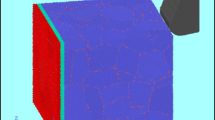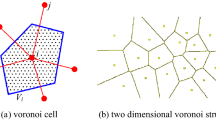Abstract
Abrasive flow polishing plays an important role as a type of precision nanomachining technology. In this study, the polishing mechanism of abrasive flow was studied using numerical simulations based on molecular dynamics. In order to study the polishing mechanism of polycrystalline materials, the molecular dynamics simulation of three kinds of polycrystalline materials was carried out. The cutting force, energy, friction coefficient, and surface morphology (during the microcutting process) of the three workpiece materials were analyzed. The analysis shows that the adhesion of atoms in the contact area on the workpiece surface will be affected by liquid phase and the type of abrasive particles, and then the surface quality polished by the abrasive flow will also be influenced. The onset of an abrasive flow polishing process involving plastic deformation (including the nucleation and migration of dislocations, grain boundary shape deformation, and deformation twinning) was observed on the workpiece surface. Defects strongly competed with each other in the form of interactions of dislocations and the grain boundaries, resulting in the migration of twin boundaries. A further analysis of the numerical results for different cutting depths and abrasive properties of the workpiece materials will be useful for understanding the different cutting effects.
Similar content being viewed by others
References
Kar, K. K., Ravikumar, N. L., Tailor, P. B., Ramkumar, J., and Sathiyamoorthy, D., “Performance Evaluation and Rheological Characterization of Newly Developed Butyl Rubber Based Media for Abrasive Flow Machining Process,” Journal of Materials Processing Technology, Vol. 209, No. 4, pp. 2212–2221, 2009.
Kenda, J., Duhovnik, J., Tavcar, J., and Kopac, J., “Abrasive Flow Machining Applied to Plastic Gear Matrix Polishing,” The International Journal of Advanced Manufacturing Technology, Vol. 71, Nos. 1–4, pp. 141–151, 2014.
Wan, S., Ang, Y. J., Sato, T., and Lim, G. C., “Process Modeling and CFD Simulation of Two-Way Abrasive Flow Machining,” The International Journal of Advanced Manufacturing Technology, Vol. 71, Nos. 5–8, pp. 1077–1086, 2014.
Sushil, M., Vinod, K., and Harmesh, K., “Experimental Investigation and Optimization of Process Parameters of Al/SiC MMCs Finished by Abrasive Flow Machining,” Materials and Manufacturing Processes, Vol. 30, No. 7, pp. 902–911, 2015.
Venkatesh, G. and Sharma, A., “Finishing of Bevel Gears Using Abrasive Flow Machining,” Procedia Engineering, Vol. 97, pp. 320–328, 2014.
Goel, S., Luo, X., and Reuben, R. L., “Wear Mechanism of Diamond Tools Against Single Crystal Silicon in Single Point Diamond Turning Process,” Tribology International, Vol. 57, pp. 272–281, 2013.
Olufayo, O. A. and Abou-El-Hossein, K., “Molecular Dynamics Modeling of Nanoscale Machining of Silicon,” Procedia CIRP, Vol. 8, pp. 504–509, 2013.
Eder, S. J., Bianchi, D., Cihak-Bayr, U., Vernes, A., and Betz, G., “An Analysis Method for Atomistic Abrasion Simulations Featuring Rough Surfaces and Multiple Abrasive Particles,” Computer Physics Communications, Vol. 185, No. 10, pp. 2456–2466, 2014.
Ghaffarian, H., Taheri, A. K., Kang, K., and Ryu, S., “Molecular Dynamics Simulation Study of the Effect of Temperature and Grain Size on the Deformation Behavior of Polycrystalline Cementite,” Scripta Materialia, Vol. 95, pp. 23–26, 2015.
Petisme, M. V. G., Gren, M. A., and Wahnström, G., “Molecular Dynamics Simulation of WC/WC Grain Boundary Sliding Resistance in WC-Co Cemented Carbides at High Temperature,” International Journal of Refractory Metals and Hard Materials, Vol. 49, pp. 75–80, 2015.
Hasheminasab, S. M. and Karimian, S. M. H., “New Indirect Method for Calculation of Flow Forces in Molecular Dynamics Simulation,” Journal of Molecular Liquids, Vol. 206, pp. 183–189, 2015.
Luo, X., Liang, Y., and Dong, S., “The Study of Molecular Dynamics Simulation of Nanometric Cutting Process of Single Crystal Al,” China Mechanical Engineering, Vol. 11, pp. 860–862, 2000.
Jiang Dalin., “Molecular Dynamics Simulation and Experimental Research of Solid-liquid Interface Wettibility,” Jiangsu: Jiangsu University, 2007.
Guo, X., Guo, D., Kang, R., and Jin, Z., “Parallel Algorithm in Molecular Dynamics Simulation Based on Monocrystal Silicon Grinding,” Chinese Journal of Mechanical Engineering, Vol. 44, No. 2, pp. 46–50, 2008.
Zhu, Y., Zhang, Y., Qi, S., and Xiang, Z., “Titanium Nanometric Cutting Process Based on Molecular Dynamics,” Rare Metal Materials and Engineering, Vol. 45, No. 4, pp. 897–900, 2016.
Zhang, J., “Molecular Dynamics Study of Generation Mechanism of Surface Layer in Nanomechanical Machining of Crystalline Copper,” Harbin: Harbin Institute of Technology, pp. 117–118, 2011.
Zhao, Y., Wei, X., Zhang, Y., Wang, J., and Huo, D., “Crystallization of Amorphous Materials and Deformation Mechanism of Nanocrystalline Materials under Cutting Loads: A Molecular Dynamics Simulation Approach,” Journal of Non-Crystalline Solids, Vol. 439, pp. 21–29, 2016.
Wen Y., Zhu R., Zhou F., and Wang, C., “An Overview on Molecular Dynamics Simulation,” Advanced in Mechanics, Vol. 33, No. 1, pp. 65–73, 2003.
Wang, Q., Bai, Q., Chen, J., Sun, Y., Guo, Y., and Liang, Y., “Subsurface Defects Structural Evolution in Nano-Cutting of Single Crystal Copper,” Applied Surface Science, Vol. 344, pp. 38–46, 2015.
Liu, D., Wang, G., Yu, J., and Rong, Y. K., “Molecular Dynamics Simulation on Formation Mechanism of Grain Boundary Steps in Micro-Cutting of Polycrystalline Copper,” Computational Materials Science, Vol. 126, pp. 418–425, 2017.
Yan, L. and Zhu, S., “The Theory and Practice of Molecular Dynamics Simulation,” Science Press, Beijing, 2013.
Girifalco, L. A. and Weizer, V. G., “Application of the Morse Potential Function to Cubic Metals,” Physical Review, Vol. 114, No. 3, pp. 687–690, 1959.
Daw, M. S. and Baskes, M. I., “Embedded-Atom Method: Derivation and Application to Impurities, Surfaces, and other Defects in Metals,” Physical Review B, Vol. 29, No. 12, pp. 6443–6453, 1984.
Mendelev, M. I. and Bokstein, B. S., “Molecular Dynamics Study of Vacancy Migration in Al,” Materials Letters, Vol. 61, Nos. 14–15, pp. 2911–2914, 2007.
Mendelev, M. I., Han, S., Son, W.-J., Ackland, G. J., and Srolovitz, D. J., “Simulation of the Interaction between Fe Impurities and Point Defects in V,” Physical Review B, Vol. 76, No. 21, Paper No. 214105, 2007.
Tersoff, J., “Modeling Solid-State Chemistry: Interatomic Potentials for Multicomponent Systems,” Physical Review B, Vol. 39, No. 8, pp. 5566–5568, 1989.
Cai, M. B., Li, X. P., and Rahman, M., “Study of the Temperature and Stress in Nanoscale Ductile Mode Cutting of Silicon Using Molecular Dynamics Simulation,” Journal of Materials Processing Technology, Vol. 192, pp. 607–612, 2007.
Author information
Authors and Affiliations
Corresponding author
Additional information
Jun-Ye Li Received PhD degree in mechanical engineering from Changchun University of Science and Technology, Changchun, China?in 2011. Now he works at Changchun University of Science and Technology. His current research interests include mechanical manufacturing and automation, precision and ultra-precision machining, multiphase flow and micro-fiction technology, and detection technology in mechanical manufacturing.
Wen-Qing Meng Received BA degree in mechanical engineering from Dezhou University, Dezhou, China?in 2016. Now he study at Changchun University of Science and Technology. His current research interests include mechanical manufacturing and automation, precision and ultra-precision machining.
Kun Dong Received MA degree in mechanical engineering from Changchun University of Science and Technology, Changchun, China?in 2017. Now he works in Hisense group. His current research interests include mechanical manufacturing and automation, precision and ultra-precision machining.
Xin-Ming Zhang Received PhD degree in mechanical engineering from Changchun University of Science and Technology, Changchun, China?in 2010. Now he works at Changchun University of Science and Technology. His current research interests include mechanical manufacturing and automation, precision and ultra-precision machining.
Wei-Hong Zhao Received ME degree in mechanical engineering from Changchun University of Science and Technology, Changchun, China?in 2005. Now he works at Changchun University of Science and Technology. His current research interests include mechanical manufacturing and automation, precision and ultra-precision machining, multiphase flow and micro-fiction technology, and detection technology in mechanical manufacturing.
Rights and permissions
About this article
Cite this article
Li, JY., Meng, WQ., Dong, K. et al. Numerical Analysis of Solid-Liquid Two-Phase Abrasive Flow in Microcutting Polycrystalline Materials Based on Molecular Dynamics. Int. J. Precis. Eng. Manuf. 19, 1597–1610 (2018). https://doi.org/10.1007/s12541-018-0187-8
Received:
Revised:
Accepted:
Published:
Issue Date:
DOI: https://doi.org/10.1007/s12541-018-0187-8




